2025-11-14 21:03:04
Welcome to the Free edition of How They Make Money.
Over 250,000 subscribers turn to us for business and investment insights.
In case you missed it:
Disney’s channels (including ESPN, ABC, and FX) have gone dark on YouTube TV after new contract talks broke down. YouTube TV quickly countered with a $20 opt-in credit for subscribers, signaling Google believes it holds the stronger hand.
Two weeks in, Disney is reportedly losing roughly $4 million per day in affiliate fees, and Monday Night Football ratings are down ~21%. Disney is pushing its new ESPN Unlimited app and its Fubo partnership to regain leverage, but early signs suggest viewers may not follow.
A decade ago, Disney was the obvious favorite: live sports, beloved franchises, must-have content. Today, distribution is the gatekeeper — and YouTube TV’s 8+ million paid subscribers may not chase another app just to watch one network. The power has shifted quietly but decisively toward the platforms that control the doorway to live television.
That makes today’s negotiations and the wider battle around content aggregation and who ultimately controls the studios at Warner all the more important.
Today at a glance:
📈 Streaming subscriber trends
🏰 Disney: Entertainment Slips
🦚 Comcast: Broadband Bleed Slows
🎥 Warner: Studios & Streaming Shine
⛰️ Paramount: New Plan & $3 Billion Cuts
📺 Roku: Strong Guidance Spark Rally
FROM OUR PARTNERS
Traditional advisors quietly skim $20,000–$100,000+ off your portfolio every year—forever.
Range doesn’t.
It’s the all-in-one wealth management platform built for $300K+ households, powered by zero AUM fees and one transparent flat rate.
No hidden cuts. No percentage games. Just relentless optimization.
Remember, Netflix capped 2024 with 302 million members, but has stopped sharing membership numbers. That leaves us focusing on the best of the rest. Let’s zoom in on the streaming platforms still reporting their figures.
Of course, the outlier here is Hulu, jumping from 55 million to 64 million in the September quarter. It was almost entirely driven by distribution-led gains rather than organic standalone growth. Disney expanded its Charter bundle footprint during the quarter, pulling millions of households into Hulu’s subscriber count even if they never actively signed up for the service.
Because Disney reports Hulu subs on a “distribution-included” basis, these bundled households count the same as retail subscribers, inflating gross adds but pressuring ARPU (which declined this quarter). In other words, Hulu didn’t suddenly become a breakout growth engine. It grew because Disney pushed Hulu deeper into carrier bundles ahead of its pivot away from reporting subscriber numbers altogether, making this spike more of a structural reporting artifact than a demand signal.
Note: Platforms like YouTube Premium, Prime Video, and Apple TV+ don’t share subscriber numbers quarterly—if at all.
Now, let’s break down how the biggest players performed this quarter.
Disney’s fiscal year ends in September, so it was Q4 FY25.
📈 Streaming stays profitable: Direct-to-consumer operating income rose 39% Y/Y to $352 million, marking a fifth straight profitable quarter. Disney+ added 4 million subscribers (reaching 132 million). Domestic ARPU was flat as higher ad revenue was offset by mix shifts, while international ARPU increased 4% on currency tailwinds.
📺 Linear remains a problem: Ongoing erosion and lower political advertising continued to weigh on Linear Networks’ profit. ESPN revenue rose 2%, but the YouTube TV blackout will hit the December quarter.
🍿 Content faces tough comps: Content Sales fell 26%, largely because last year included Inside Out 2 and Deadpool & Wolverine. Lilo & Stitch remained the highest-grossing Hollywood film of the year. Q1 FY26 will see a $400 million operating income hit from the theatrical timing of Zootopia 2 and Avatar: Fire and Ash.
🏰 Experiences are the profit and growth driver: Experiences revenue rose 6% to $8.8 billion, with operating income up 13% to $1.9 billion. Disneyland Paris and consumer products licensing stood out, helping offset softer China parks attendance. Cruise demand remained robust, with high utilization and bookings up 3% for the upcoming quarter. Q1 FY26 will face $150 million in pre-opening and dry-dock expenses tied to new ships — a temporary drag on margins.
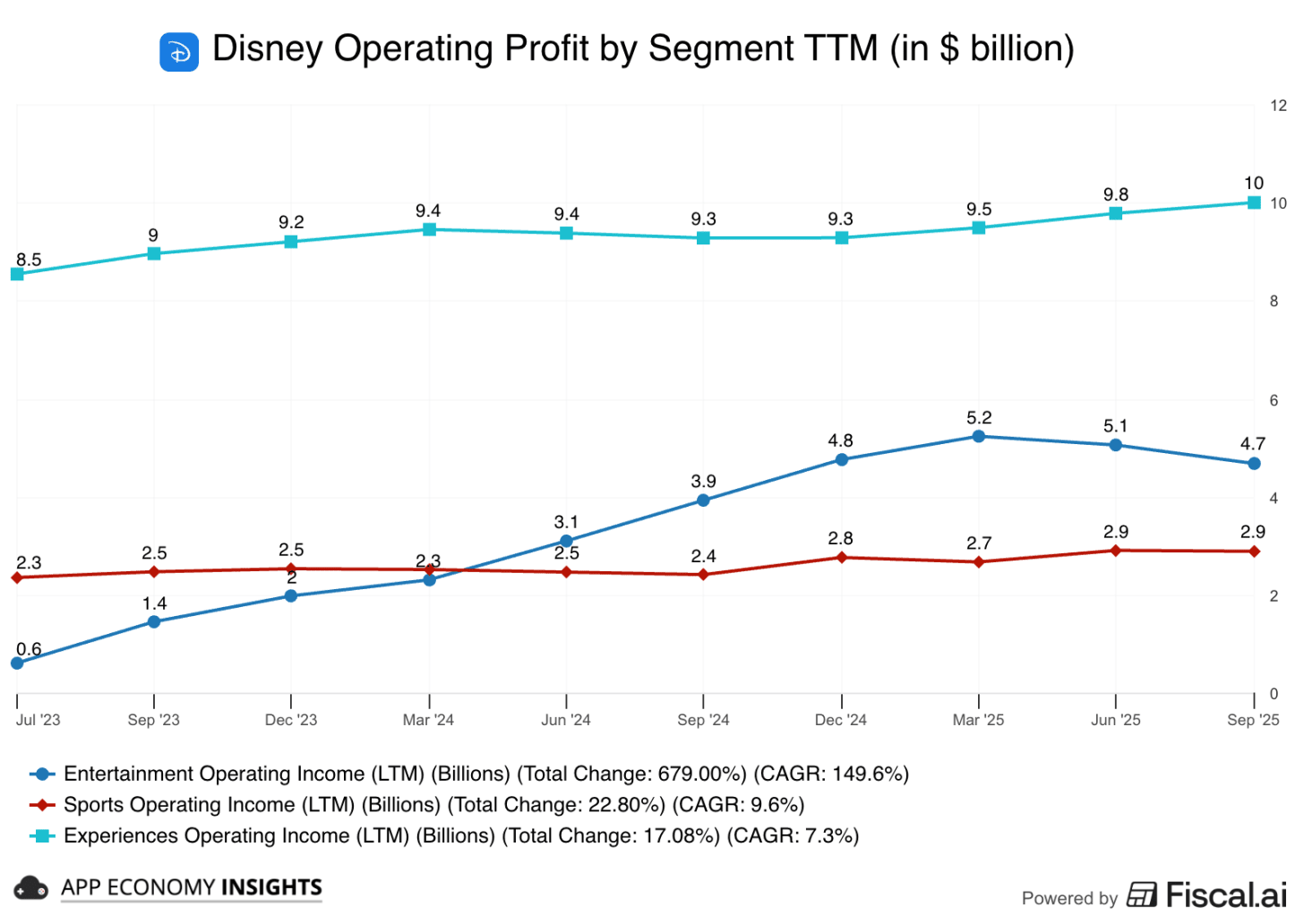
🔮 Updated guidance: Management reiterated double-digit adjusted EPS growth for FY26 and FY27, with gains weighted toward the back half due to film marketing costs, political ad headwinds, and sports-rights timing. Disney plans to double share repurchases to $7 billion in FY26 and raised its annual dividend 50% to $1.50 per share. Free cash flow is expected to rise meaningfully as investment levels normalize and DTC profitability scales.
What to make of all this?
Disney’s DTC business is now a consistent profit engine, and parks and cruises continue to offset linear pressure. But the Entertainment segment remains challenged, with weaker film output and shrinking TV revenue. With a stronger FY26 slate (The Mandalorian, Toy Story 5, Moana, Avengers: Doomsday), the path forward hinges on stabilizing Entertainment while DTC and Experiences do the heavy lifting.
📸 Big picture: Revenue fell 3% Y/Y to $31.2 billion ($0.5 billion beat), but this was entirely due to a tough comparison with last year’s Paris Olympics. Excluding the Olympics, revenue was up 3%. Adjusted EPS was flat at $1.12 ($0.02 beat), and free cash flow rose 45% Y/Y to $4.9 billion.
📉 Broadband losses improve: This was the main story. Comcast lost only 104,000 broadband customers in Q3, a major improvement from Q2’s 226,000 loss and far better than the ~140,000 analysts had feared. Pay-TV losses also slowed to 257,000 (the smallest loss in several years). Wireless was the star again, adding a new record of 414,000 lines, bringing its total to 8.9 million.
🦚 Peacock growth stalls: Peacock’s paid subscribers were flat sequentially at 41 million (missing estimates). Revenue was $1.4 billion (down Y/Y due to the Olympics comparison, but up excluding it). Adjusted EBITDA losses widened sequentially to $217 million (from $101 million in Q2 and worse than analysts expected), though this was still a large improvement versus the prior year’s $436 million loss.
🎥 Studio boosted by Dinos: Universal Studios revenue rose 6% to $3.0 billion, driven by the strong theatrical run of Jurassic World: Rebirth (which grossed nearly $900 million global box office) and higher content licensing. However, Studio’s EBITDA fell 22% to $365 million due to higher marketing and production costs for its upcoming slate.
🎢 Epic Universe still surging: Theme parks revenue continued its massive run, jumping 19% to $2.7 billion. EBITDA grew 13% to $958 million, fueled by the first full quarter of Epic Universe driving record attendance and per-capita spending.
📺 Versant spinoff & WBD rumors: Comcast confirmed its spinoff of cable channels (USA, CNBC, etc.) into Versant Media Group and will host an Investor Day on December 4, with the separation expected in “early 2026.” On the WBD rumors, co-CEO Mike Cavanagh said the “bar is very high” for M&A but confirmed they would “look at things,” specifically naming “streaming assets and studio assets” as complementary.
What to make of all this?
This quarter was a mixed bag. Broadband subscribers were better than feared, but this stabilization is coming at a high cost. Co-CEO Mike Cavanagh stated the competitive environment “will not change anytime soon” and that investments in pricing will cause more profitability pressure (and a 4% EBITDA decline) on the core connectivity unit in the coming quarters. The growth engines (Wireless/Parks) are on track, but Peacock’s stall is a soft spot. Maybe the NBA coming to Peacock will change that in Q4.
🍿 Studios on a roll: Studios revenue soared 24% Y/Y to $3.3 billion ($0.2 billion beat), with adjusted EBITDA more than doubling to $695 million. The segment was powered by hits like Superman, Weapons, and The Conjuring: Last Rites, becoming the first studio to pass $4 billion in global box office for 2025 with only 11 films. Management now expects to “meaningfully exceed” prior guidance, targeting at least $3 billion in Studios EBITDA for 2025.
📺 Linear woes accelerate: Global Networks revenue plummeted 22% Y/Y to $3.9 billion, and EBITDA fell 20% to $1.7 billion. The steep drop was worsened by comparison to last year’s Olympics, but even excluding that, revenue fell 12%. The segment continues to be hit hard by cord-cutting (carriage fees -8%) and a weak ad market (ad sales -20%), with the loss of NBA rights expected to create further headwinds in Q4.
📈 Streaming profits grow, but ARPU dips again: The streaming segment added 2.3 million subscribers (below analyst projections, attributed to a quieter content quarter lacking hits like The White Lotus), reaching 128 million globally (on track for 150 million by 2026). Revenue was flat at $2.6 billion, but adjusted EBITDA grew 19% Y/Y to $345 million. Management remains confident in hitting $1.3 billion in streaming EBITDA for 2025. However, ARPU continues to slide, falling 16% globally to $6.64 due to international expansion and domestic carriage deal renewals. Management signaled that price hikes and a password-sharing crackdown are coming.
💵 Debt down, but net loss recorded: WBD reported total revenue of $9.0 billion ($0.2 billion miss), but its net loss of $148 million or 6 cents/share was ahead of low expectations ($0.01 beat). The loss included $1.3 billion in amortization and restructuring costs. The company paid down another $1.2 billion in debt, bringing gross debt to $34.5 billion and holding net leverage steady at 3.3x.
🪧 “For Sale” sign is up: The biggest news is a formal “strategic review” announced in October after WBD received “unsolicited interest.” CEO David Zaslav confirmed, “It’s fair to say we have an active process underway.” The board is now considering all options: 1) proceeding with the planned mid-2026 split, 2) selling the entire company, or 3) selling off pieces. Suitors reportedly include Comcast, Paramount, Netflix, and Amazon. Paramount has reportedly made three separate offers, all of which were rebuffed. Despite the sale talks, both Zaslav and the company Chairman have indicated they still prefer the planned split.
What to make of all this?
The “Warner Bros.” side (Studios & Streaming) is showing strong profit growth, proving the value of its IP and scale. The “Discovery Global” side (Linear) is declining as expected, but the ad slump is making it worse. The strategic review confirms that the market sees value in the assets (especially Studios), and the company is now officially “in play” even as it continues to execute its planned separation.
📸 Big picture: In its first report as Paramount Skydance, the new company missed Q3 Wall Street expectations. Revenue was flat at $6.7 billion ($0.3 billion miss), and adjusted loss was 12 cents per share (a huge $0.50 miss). However, the stock rallied as investors cheered the new CEO’s aggressive forward-looking plan, which included $30 billion revenue guidance for 2026 ($0.2 billion beat).
📉 TV Media sinks results: The traditional TV segment was the main drag, with revenue plummeting 12% Y/Y to $3.8 billion. Ad revenue fell 12% (blamed on lower political spending), and affiliate revenue fell 7% from cord-cutting. This segment is now the main target for cuts, including the divestiture of TV businesses in Argentina and Chile.
📈 Streaming is the bright spot: The Direct-to-Consumer (DTC) segment revenue grew 17% Y/Y to $2.2 billion, driven by a 24% jump in Paramount+ revenue. Paramount+ added 1.4 million subscribers (reaching 79.1 million total) and grew ARPU by 11%. Management guided for full-year 2025 DTC profitability and “profitability growth in 2026.”
🎬 Studio stumbles: The Filmed Entertainment segment swung to a loss of $49 million. Revenue grew 30% to $756 million, but this was attributed to consolidating Skydance’s licensing. The theatrical slate underperformed, with films like Smurfs and The Naked Gun cited as disappointments.
♟️ New Strategy: Cut, Spend, and Hunt: The new Skydance-led management team set a bold new course:
Cut: Increased the total cost-savings target from $2 to $3 billion. This includes an additional 1,600 job cuts (tied to asset sales) and ~600 voluntary severances from a new 5-day return-to-office policy.
Spend: Plans to increase content investment by an incremental $1.5 billion in 2026 to “rebuild” the film slate (targeting 15+ movies/year) and bolster streaming.
Talent: Ellison is aggressively re-stacking the creative roster, signing deals with the UFC ($7.7 billion over 7 years), the creators of Stranger Things, and director James Mangold. He also acquired The Free Press for $150 million, installing Bari Weiss as editor-in-chief of CBS News. However, this new direction comes with friction, as Yellowstone creator Taylor Sheridan is reportedly leaving for NBCUniversal.
Hunt: While reportedly submitting three rejected bids for WBD, David Ellison downplayed M&A as a necessity, stating, “there are no must-haves for us. We really look at this as ‘buy versus build’ [...] we absolutely have the ability to build.”
Streamline: Announced plans to unify the tech backend for Paramount+, Pluto TV, and BET+ by mid-2026, and announced another price hike for Paramount+ effective January 2026.
What to make of all this?
This was a messy “kitchen sink” quarter where the (bad) Q3 results were completely overshadowed by the (bold) 2026 plan. Investors cheered the new strategy, sending the stock soaring. Ellison’s plan is now clear: aggressively cut from the declining linear business and plow that money (and more) into “building” the growth engines (UFC and a rebuilt studio). The talent shakeup shows a definitive break from the past.
📸 Big picture: Roku reported a massive Q3 earnings beat and strong guidance, causing the stock to rally. Total revenue grew 14% Y/Y to $1.21 billion (in line with estimates), but the company posted a surprise profit of $0.16 per share ($0.07 beat). Roku also achieved its first positive operating income since 2021, generating $25 million in net income (from last year’s $9 million loss).
📈 Platform shines: The high-margin Platform segment continues to drive the business. Revenue grew 17% Y/Y to $1.1 billion, driven by strength in video advertising and streaming service subscriptions. Management noted strong momentum from its self-serve ad platform (Roku Ads Manager) and the new integration with Amazon’s DSP.
📉 Hardware is still a loss-leader: The Devices segment revenue fell 5% Y/Y to $146 million. As expected, the hardware continues to be sold at a loss to grow the user base, posting a negative 16% gross margin ($23 million loss).
📊 Key metrics miss: Roku’s total Active Accounts hit “roughly 90 million.” However, streaming hours of 36.5 billion (+9% Y/Y) came in just below analyst estimates of ~37 billion. Notably, Roku has stopped reporting ARPU (Average Revenue Per User) as it focuses on total profit, following in Netflix’s footsteps.
🔮 Guidance & strategy: The biggest news was the strong forecast. Roku raised its full-year 2025 outlook, lifting revenue guidance to $4.69 billion($40 million raise) and massively increasing its full-year net income target to $50 million (up from a prior $20 million estimate).
What to make of all this?
The unexpected rise in the full-year profit forecast lifted investors’ spirits. Roku is proving its pivot to profitability is working faster than expected, and the market rewarded this new operating leverage, overshadowing the minor engagement miss.
📊 Stay tuned for 15 companies visualized tomorrow in our PRO coverage!
Tencent, Sony, Nu, CoreWeave, Instacart, and more.
That’s it for today!
Stay healthy and invest on!
Thanks to Fiscal.ai for being our official data partner. Create your own charts and pull key metrics from 50,000+ companies directly on Fiscal.ai. Start an account for free and save 15% on paid plans with this link.
Disclosure: I own AAPL, AMZN, GOOG, NFLX, and ROKU in App Economy Portfolio. I share my ratings (BUY, SELL, or HOLD) with App Economy Portfolio members.
Author's Note (Bertrand here 👋🏼): The views and opinions expressed in this newsletter are solely my own and should not be considered financial advice or any other organization's views.
2025-11-11 21:03:35
Welcome to the Premium edition of How They Make Money.
Over 240,000 subscribers turn to us for business and investment insights.
In case you missed it:
FROM OUR PARTNERS
When powerful entertainment brands secure valuable character IP, media giants pay billions to own it.
Disney paid $4B for Marvel.
Disney paid $4B for Lucasfilm.
Universal spent $1B+ on DreamWorks.
Now, Elf Labs owns a portfolio of 500+ trademarks & copyrights, that includes iconic characters like Cinderella and Snow White — and is transforming them with AI and next-gen media tech.
Their character portfolio has already generated $15M+ in royalties, and now the team–who is behind $6B+ in licensing deals across global entertainment brands–just secured a 200M+ TV distribution deal.
Elf Labs may be positioned for the same acquisition pattern — but shares are still available to everyday investors at just $2.25/share. And you can still secure 20% bonus shares if you invest by November 13th.
This is a paid advertisement for Elf Lab’s Regulation CF offering. Please read the offering circular at https://www.elflabs.com/
First-party data from millions of cars, vertically integrated factories, and a cost per mile expected to collapse over time. The market has rewarded that vision with a $1.4 trillion valuation—a bet on a future where human drivers disappear, car ownership fades, and every vehicle becomes a computer on wheels.
Now contrast that with everyone else.
Even if you combined the market caps of every company in rideshare and delivery, you’d still fall short of half a trillion dollars. And for good reason: today’s on-demand platforms are expensive, low-margin, and constrained by human supply.
So it’s fair to ask: Is there any autonomy upside for demand aggregators?
The market doesn’t think so. Uber trades at roughly 22x trailing free cash flow, a metric that has tripled in the past two years.
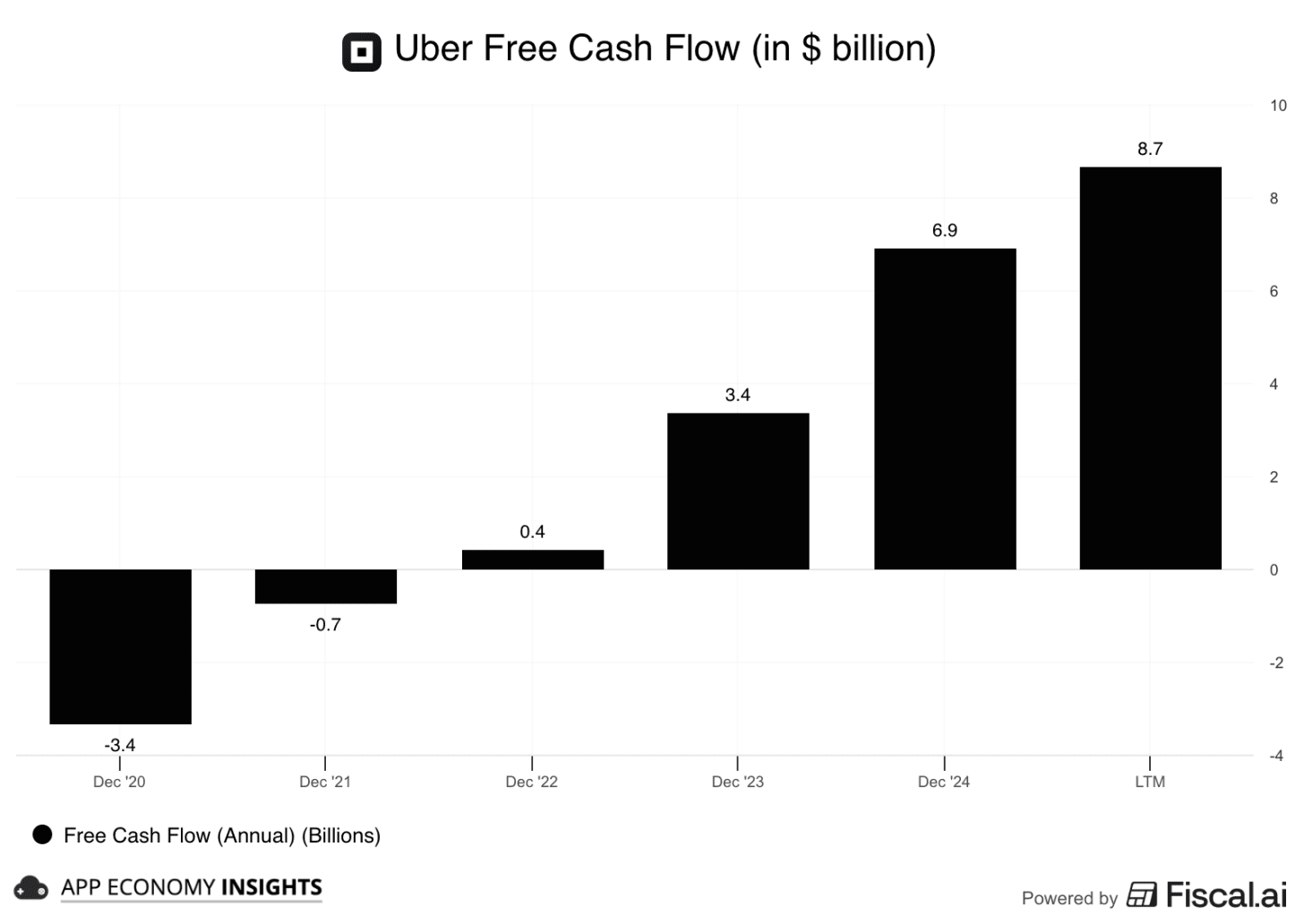
And yet, the latest Uber–NVIDIA partnership may point to a different outcome.
NVIDIA will supply the “L4 brain” and AI training computers. Uber brings the global ride-and-delivery network, driving data, and fleet-management infrastructure. Together, they’re building an AV Technology Ecosystem to bring “Uber-ready” autonomous vehicles to market. It’s the next step in Uber’s quiet AV expansion, already spanning 20+ partners. You can already order a Waymo on Uber in cities like Atlanta and Austin.
Why should you care? Because this partnership shifts autonomy from speculative to deployable. If Uber can integrate AVs at scale, its moat expands—from network effects and driver liquidity to data, logistics, and operational leverage. That could reprice what a rideshare business is worth.
The big idea: Uber’s alliance with NVIDIA marks a turning point. The question is not whether Tesla will dominate autonomy—but whether the platforms that control demand today can capture a meaningful share of the value. The ripple effects touch valuations, competitive advantage, and the entire timeline of disruption.
Today at a glance:
🚖 Uber: AV Aggregation Theory.
🛵 Grab: The Superapp Angle.
🚘 Lyft: Pragmatic Follower.
First, let’s look at where Uber is today. Q3 revenue rose 20% Y/Y to $13.5 billion ($240 million beat). A large one-off tax benefit distorted the net profit for the quarter, so it’s best to focus on operating profit.
Gross Bookings (the total dollar value spent by end users on Uber apps) surged 21% Y/Y to $49.7 billion (accelerating).
🚗 Mobility +20% Y/Y to $21.0 billion with a 30.6% take rate.
🛵 Delivery +25% Y/Y to $18.7 billion with a 19.2% take rate.
🚚 Freight flat Y/Y at $1.3 billion.
Monthly Active Platform Consumers (MAPC) rose 17% to 189 million.
Trips grew even faster at 22% Y/Y to 3.5 billion.
Despite the large top-line beat, adjusted EBITDA (up 33% Y/Y to $2.3 billion) and operating income of $1.1 billion both missed expectations, with management citing one-off legal and regulatory charges of $0.5 billion for the shortfall. It would have been a large beat without this temporary headwind. Free cash flow remained robust at $2.2 billion.
Looking ahead, Uber provided a mixed Q4 forecast. Gross Bookings guidance (+19% Y/Y to ~$53 billion) came in ahead of consensus, but the Q4 adjusted EBITDA forecast of (+34% Y/Y to ~$2.46 billion) fell $30 million short of analyst expectations. The trend remains very much alive, with adjusted profitability outpacing revenue growth and margins expanding.
The company prepares to shift its profit reporting to adjusted operating income (or adjusted EBIT) in 2026, a more conservative measure than adjusted EBITDA since it doesn’t exclude the DA part (Depreciation and Amortization). This approach makes sense since Uber has become a more mature, profitable business.
CEO Dara Khosrowshahi outlined six strategic growth areas:
Deepening engagement (more trips per user).
Hybrid future (human drivers + AVs).
Local commerce (grocery & retail).
2025-11-08 23:02:45
Welcome to the Saturday PRO edition of How They Make Money.
Over 240,000 subscribers turn to us for business and investment insights.
In case you missed it:
📊 Monthly reports: 200+ companies visualized.
📩 Tuesday articles: Exclusive deep dives and insights.
📚 Access to our archive: Hundreds of business breakdowns.
📩 Saturday PRO reports: Timely insights on the latest earnings.
Today at a glance:
🦎 Berkshire: Buffett’s Final Call
🍟 McDonald’s: Deals Are Working
📲 Qualcomm: Handsets Rebound
📱 Arm: AI Data Center Bet Pays Off
🌐 Arista Networks: AI Targets Soar
🇩🇰 Novo Nordisk: New Guidance Cut
🧬 Amgen: Core Franchises Boost
💉 Pfizer: Cost Cuts Drive Beat
🪶 Robinhood: Crypto Miss
☕️ Starbucks: Turnaround Takes Hold
🛖 Airbnb: International Strength
🏨 Marriott: US Softness Persists
🏎️ Ferrari: Pricing Power Shines
🔒 Fortinet: SASE Soars
🇰🇷 Coupang: Triple-Digit Taiwan Growth
⚡️ Axon: AI Growth Pain
🐶 Datadog: Broad-Based Growth
🎮 Take-Two: GTA VI Delayed Again
🔲 Block: Gross Profit Acceleration
🌮 YUM Brands: Pizza Hut on the Block
🎤 Live Nation: Global Growth Fuels Record
✈️ Expedia: B2B Jumps
📢 HubSpot: AI & Multi-Hub Traction
📺 The Trade Desk: Kokai Fuels a Beat
🎨 Figma: $1 Billion Run Rate
📌 Pinterest: Weak Outlook
🍞 Toast: ARR Tops $2 Billion
💬 Twilio: Growth Accelerates Again
🌎 Global Payments: Genius Momentum
🧬 Tempus AI: First-Time EBITDA Positive
👑 DraftKings: Guidance Slashed
👻 Snap: AI Partnership Fuels Blowout
🦉 Duolingo: Missing the Streak
💻 Paycom: AI Efficiencies Continue
💊 Hims & Hers: Novo Talks Relaunched
🗞️ NYT: Subscriber Growth Accelerates
⚡️ Celsius: Turning Into a Monster
🏴 Klaviyo: Retention Rebounds
🔥 Match Group: Hinge Acceleration
🌊 Digital Ocean: AI Demand Accelerates
🚲 Peloton: Profitability Uptick
🍽️ Tripadvisor: “Experiences-Led” Reorg
🎓 Docebo: Core Growth Masked
🍿 AMC: Box Office Softens
Berkshire Hathaway’s operating earnings improved to $14.4 billion in what marks Warren Buffett’s final earnings call as CEO. Revenue grew 2% to $95.0 billion, while net earnings rose 17% to $30.9 billion.
The operating profit jump was driven almost entirely by the insurance underwriting business, where earnings more than tripled to $2.4 billion due to a mild catastrophe season. Profit gains at BNSF (+5%) and manufacturing (+8%) also helped offset a 9% decline at Berkshire Hathaway Energy.
The cash hoard swelled to a new record of $382 billion, up from $344 billion in June. Berkshire’s cautious stance continued, with no share buybacks for the fifth straight quarter and net equity sales of $6.1 billion. The company has been a net seller of stocks for the 12th consecutive quarter.
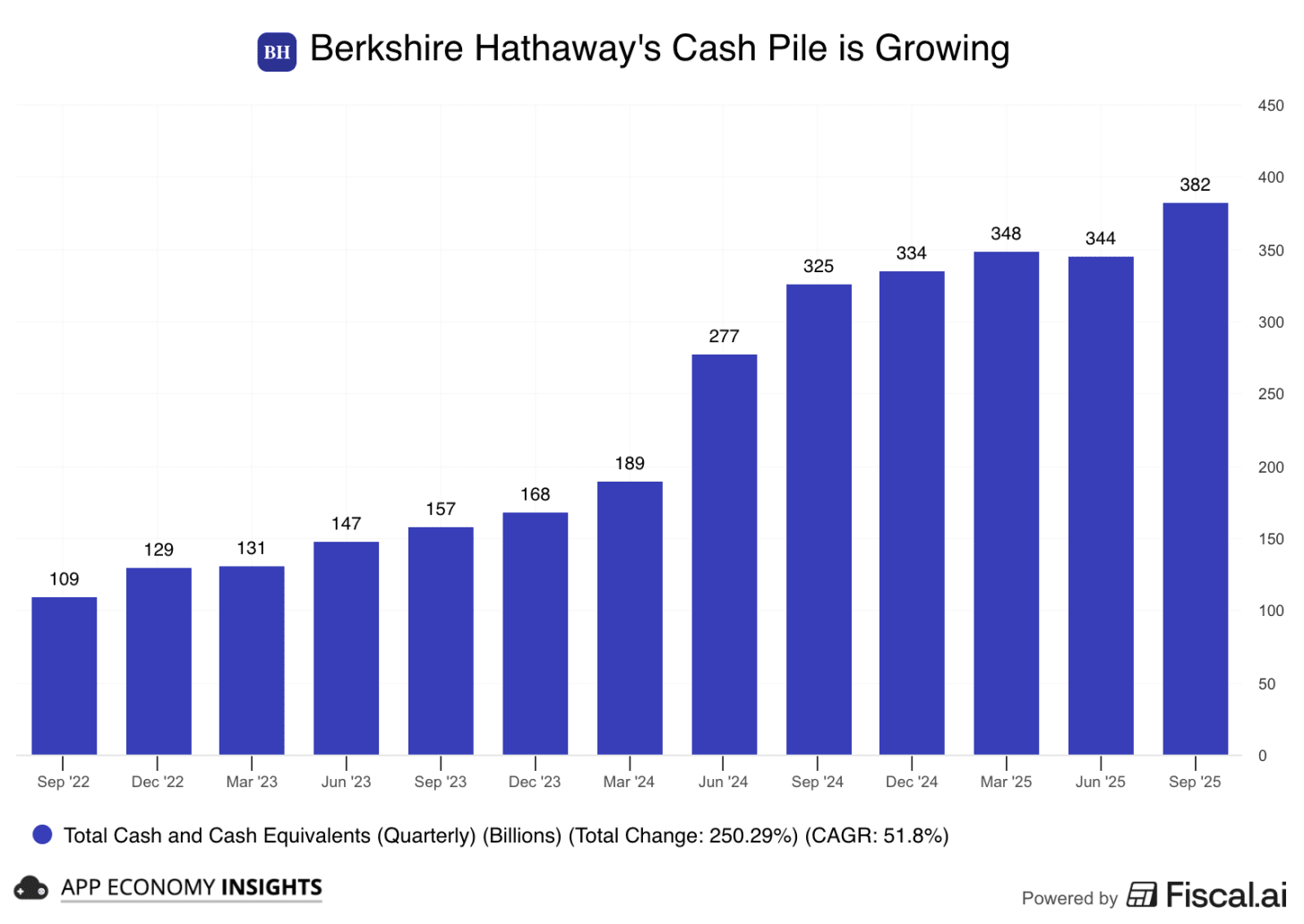
With Buffett set to step down as CEO at year-end, successor Greg Abel inherits the massive war chest and a stock that has underperformed since the retirement announcement. However, Abel’s first major move was announced just after Q3 closed: a $9.7 billion deal to buy OxyChem, signaling a new catalyst and the first significant deployment of the cash pile.
McDonald’s Q3 revenue rose 3% Y/Y to $7.1 billion ($10 million miss), and adjusted EPS was $3.22 ($0.11 miss). The profit miss was driven by $91 million in one-time restructuring and transaction charges related to its South Korea and Israel businesses.
Global same-store sales continued their rebound, rising 4% (beating estimates), and US comps grew 2% (also a beat). US growth was driven by positive check growth from successful promotions like the Snack Wrap and various value bundles.
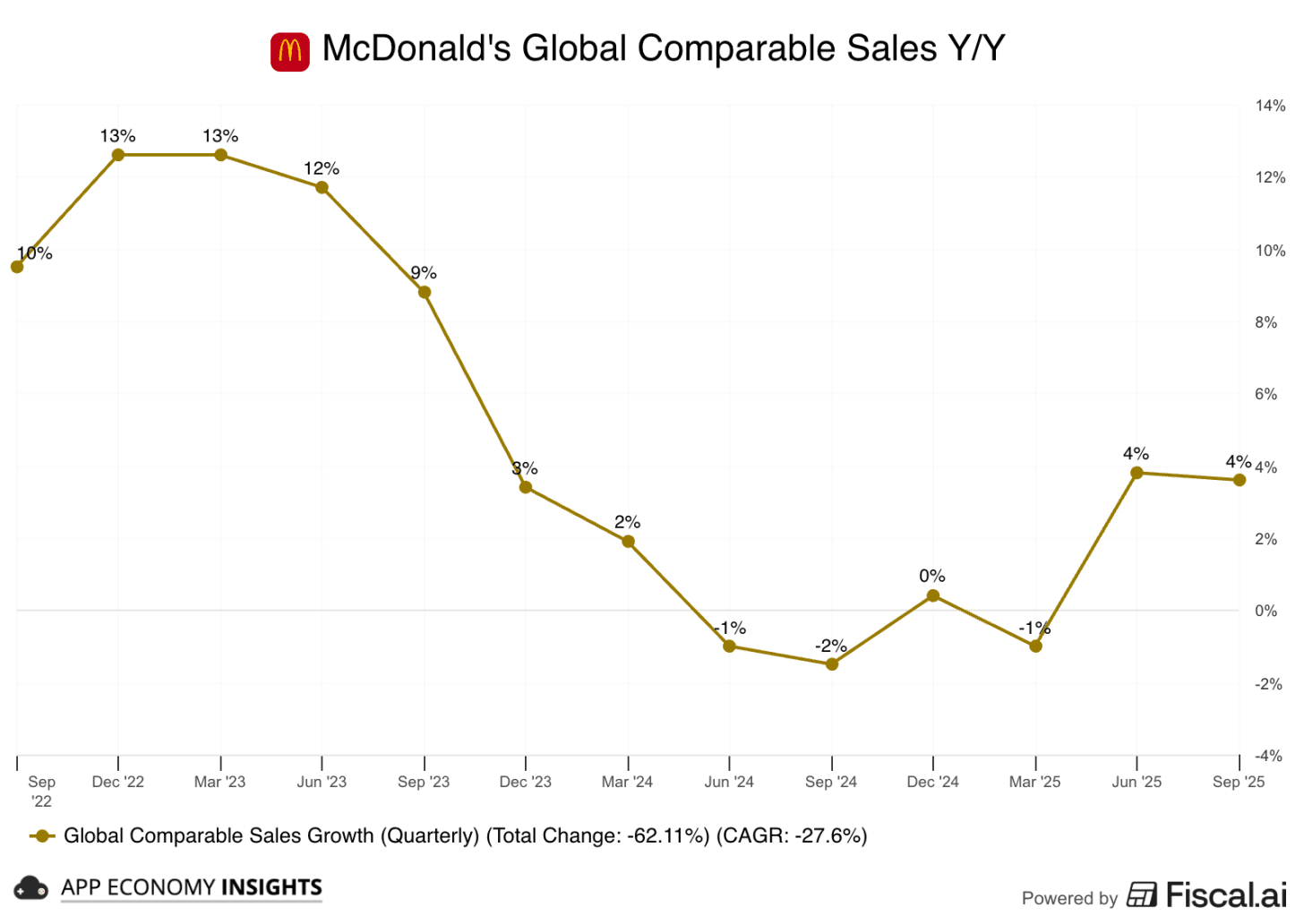
International Operated Markets (+4%) and International Developmental Licensed Markets (+5%) once again outperformed the US, with strong results in Germany, Australia, and Japan.
McDonald’s reaffirmed its full-year operating margin guidance in the mid-to-high 40% range. Loyalty sales continued to surge, hitting a record $9 billion for the quarter ($34 billion for the trailing twelve months) as the company remains on track for its 250 million loyalty user target.
Despite a “challenging environment,” CEO Chris Kempczinski highlighted that the company is “fueling momentum” by delivering “everyday value and affordability.” The strategy is working, as McDonald’s appears to be successfully winning over cash-strapped consumers who are pulling back from fast-casual rivals like Chipotle.
Qualcomm’s fiscal Q4 (September quarter) revenue rose 10% Y/Y to $11.3 billion ($510 million beat), with non-GAAP EPS of $3.00 ($0.13 beat). The results were driven by a 13% Y/Y growth in the QCT segment to $9.8 billion.
Handsets revenue was the standout, jumping 14% Y/Y to $7.0 billion, signaling strong demand in the premium Android tier, particularly from Samsung. Automotive revenue hit a record $1.1 billion (+17% Y/Y), and IoT grew 7% to $1.07 billion. Licensing (QTL) revenue fell 7% Y/Y to $1.4 billion.
Despite a $5.7 billion non-cash one-off charge related to a US tax bill, the company generated record free cash flow of $12.8 billion for the full fiscal year and returned $3.4 billion to shareholders in the quarter.
Management issued a blockbuster Q1 FY26 forecast, guiding revenue to $11.8–$12.6 billion and non-GAAP EPS to $3.30–$3.50, both well above consensus. The company expects record QCT Handsets revenue in Q1, driven by new Snapdragon flagship launches. CEO Cristiano Amon highlighted momentum in AI PCs (150+ designs in pipeline), automated driving, and an accelerating push into the AI data center market, with a ramp now expected in FY27.
2025-11-07 21:02:51
Welcome to the Free edition of How They Make Money.
Over 240,000 subscribers turn to us for business and investment insights.
In case you missed it:
The AI-powered Siri teased back in June 2024 still hasn’t made its debut.
According to Bloomberg’s Mark Gurman, Apple plans to pay Google ~$1 billion a year to use a custom version of Gemini to power next-gen Siri, handling tasks like summaries and planning. The new model would pack 1.2 trillion parameters, compared to roughly 150 billion for the current Apple Intelligence model.
$1 billion is a rounding error for these two Silicon Valley giants. The real story is who Apple chose. After testing models from Anthropic and OpenAI (including ChatGPT), it still went with Google.
Apple’s goal is to replace Gemini with its own model, eventually.
But don’t hold your breath.
Today at a glance:
🕵️ Palantir: Otherworldly Growth
↗️ AMD: Data Center Margins Miss
📱 AppLovin: AI Drives Record Profits
🛍️ Shopify: Growth & AI Costs Soar
🎧 Spotify: Ad Slump Continues
FROM OUR PARTNERS
Range helps high-earners maximize their wealth with smart tax and investing strategies:
Max out your:
401(k) ($23,500, +$7,500 if 50+).
HSA ($4,300 individual/$8,550 family).
IRA ($7,000).
Leverage the $40,000 SALT cap, $15M estate tax exemption, or Roth conversions.
Gift $19,000/person tax-free, superfund 529s ($95,000), or harvest tax losses ($3,000 deduction).
Range’s real-time insights, flat fees, and expert guidance simplify it all.
Palantir smashed expectations, with Q3 revenue jumping 63% Y/Y to $1.18 billion ($90 million beat) and non-GAAP EPS of $0.21 ($0.04 beat). The company’s dollar-based net retention reached a “best in class” 134%.
CEO Alex Karp called the growth “accelerating and otherworldly,” stating the results “make undeniable the transformational impact of using AIP to compound AI leverage.”
The real story: US commercial revenue soared 121% Y/Y to $397 million, while US government revenue climbed 52% to $486 million. US Commercial Total Contract Value rocketed 342% Y/Y to $1.3 billion, setting up a long runway of booked revenue ahead.
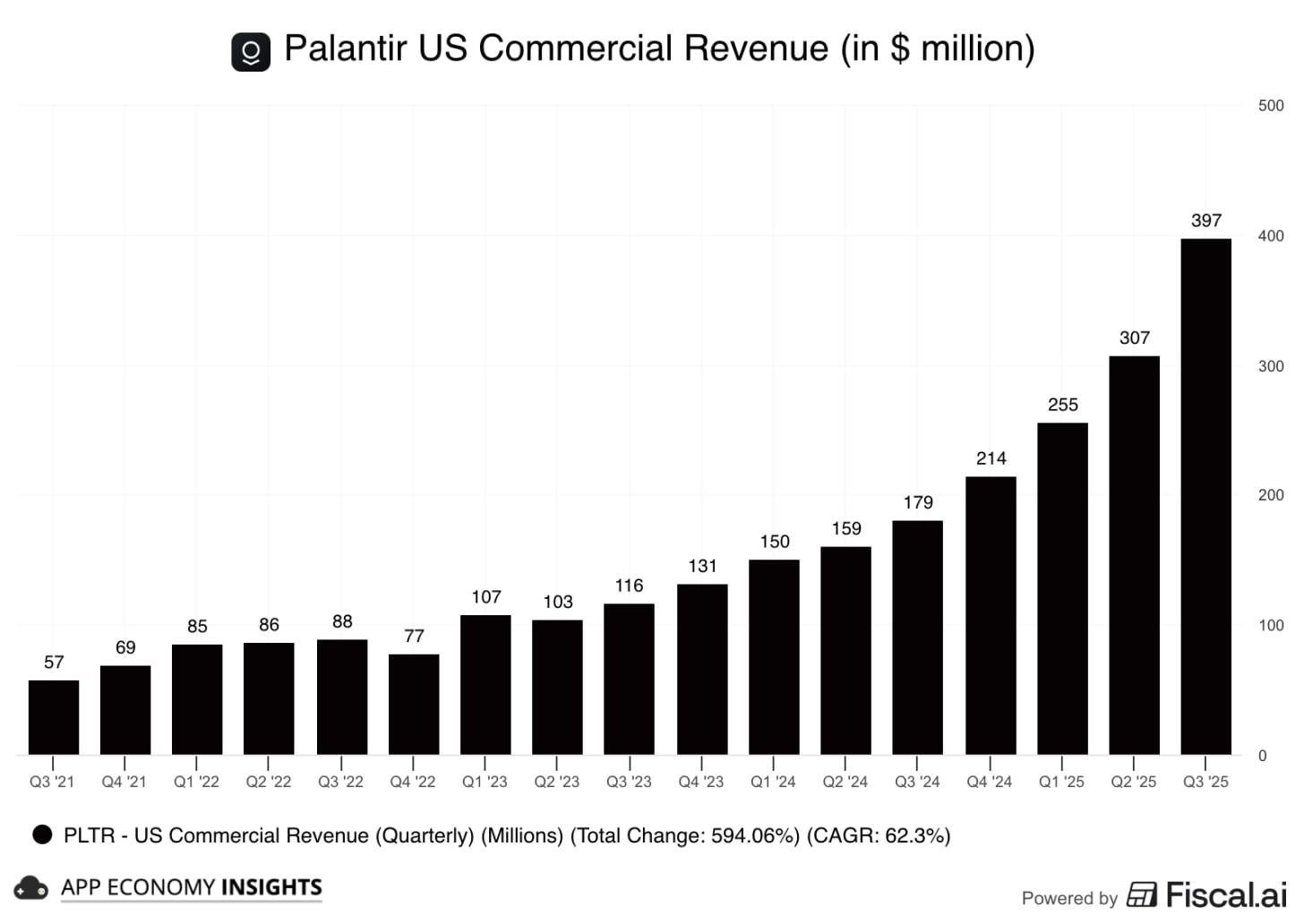
Management raised its FY25 guidance again, now targeting ~$4.40 billion in revenue ($150 million raise), including US commercial revenue expected to more than double to $1.43 billion ($131 million raise). Adjusted free cash flow is now projected at ~$2.0 billion ($100 million raise).
Palantir notched a record Rule of 40 score of 114% (up from 94% in Q2) and a record Total Contract Value (TCV) of $2.76 billion (+151% Y/Y). Its AI platform continues to win massive deals, with no signs of slowing down.
But here’s the twist: PLTR is an 11‑bagger (up 1,000%) since it entered our real-money portfolio in January 2024, a testament to the wild investor enthusiasm surrounding AI. Palantir is trading at the top end of the S&P 500’s valuation range. And despite stellar results, the stock fell 15% in the days after earnings, illustrating that much of the upside was already priced in.
Bottom line: Palantir’s growth is otherworldly, but so is its valuation. That requires stellar execution for the foreseeable future.
AMD’s Q3 revenue surged 36% Y/Y to a record $9.2 billion ($500 million beat), while adjusted EPS of $1.20 also beat estimates ($0.03 beat). The results were driven by broad-based demand for EPYC processors, Ryzen CPUs, and Instinct AI accelerators.
↗️ Data Center revenue rose 22% Y/Y to $4.3 billion ($200 million beat), driven by strong demand for 5th Gen EPYC processors and the MI350 AI accelerator ramp. However, the segment’s operating income of $1.1 billion missed expectations, with operating margins falling to 25% (from 29% a year prior).
💻 Client and Gaming revenue was the standout, soaring 73% Y/Y to $4.0 billion. Client revenue hit a record $2.8 billion (+46% Y/Y), fueled by record Ryzen processor sales. Gaming revenue exploded 181% Y/Y to $1.3 billion, driven by higher semi-custom console revenue and strong Radeon GPU demand.
📉 Embedded revenue declined 8% Y/Y to $0.9 billion.
The Q4 outlook beat expectations. AMD guided revenue to ~$9.6 billion (midpoint), roughly $400 million above consensus, with gross margin expected to expand to 54.5%. Notably, this forecast still excludes expected revenue from MI308 shipments to China.
CEO Lisa Su called it an “outstanding quarter” and a “clear step up in our growth trajectory.” Despite the strong top-line and improved guidance, the stock fell as investors likely focused on the data center margin miss and an AI growth trajectory that, while strong, has not yet met the market’s high expectations.
AppLovin is now operating as a pure-play ad-tech company following its app business divestiture.
Q3 revenue surged 68% Y/Y to $1.41 billion ($70 million beat), with the adjusted EBITDA margin reaching an impressive 82%. Even NVIDIA and Visa don’t hit such a high number. GAAP EPS was $2.45 ($0.06 beat), and free cash flow jumped 92% Y/Y to $1.05 billion.
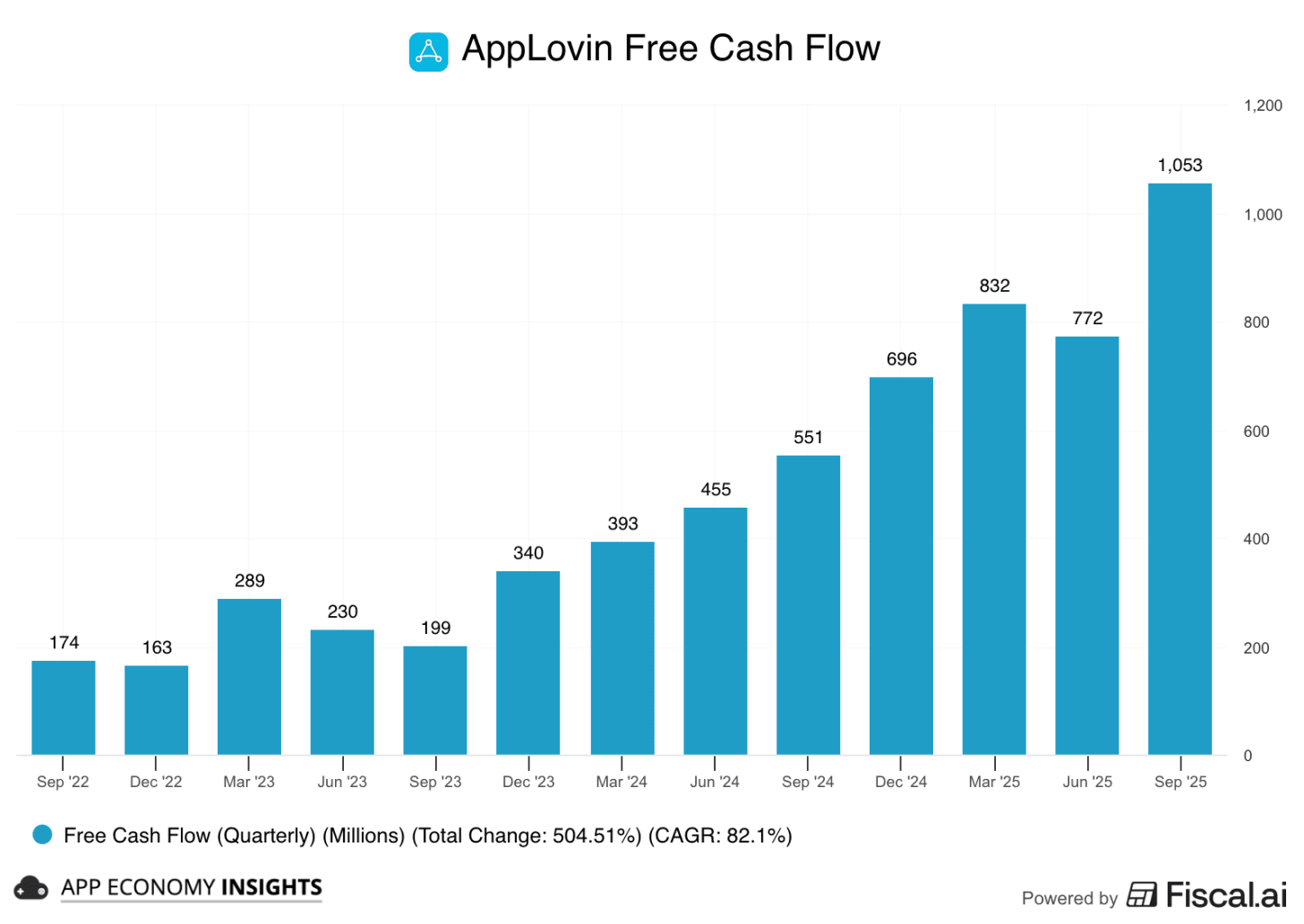
AppLovin’s core ad tech business continued to fire on all cylinders, leading to its recent inclusion in the S&P 500. The AXON self-serve platform launched on October 1st, and management reported very strong early signals, with spend from new advertisers growing ~50% week-over-week.
Management guided for a strong Q4, with revenue of $1.57–$1.60 billion (well ahead of the $1.55 billion consensus) and a stable adjusted EBITDA margin of 82-83%.
The company also announced a new $3.2 billion share buyback authorization. While rumors of regulatory investigations (SEC, state AGs) regarding data practices have created an overhang, the company’s impressive execution, record profitability, and the promising initial ramp of its self-serve platform show accelerating momentum in its core AI-driven ad-tech business.
Shopify’s Q3 revenue jumped 32% Y/Y to $2.84 billion ($80 million beat), and Gross Merchandise Volume (GMV) also surged 32% to $92 billion ($3 billion beat). Growth was strong in North America and internationally, with Merchant Solutions revenue rising 38% Y/Y to $2.15 billion, while Subscription Solutions grew 15% Y/Y to $699 million.
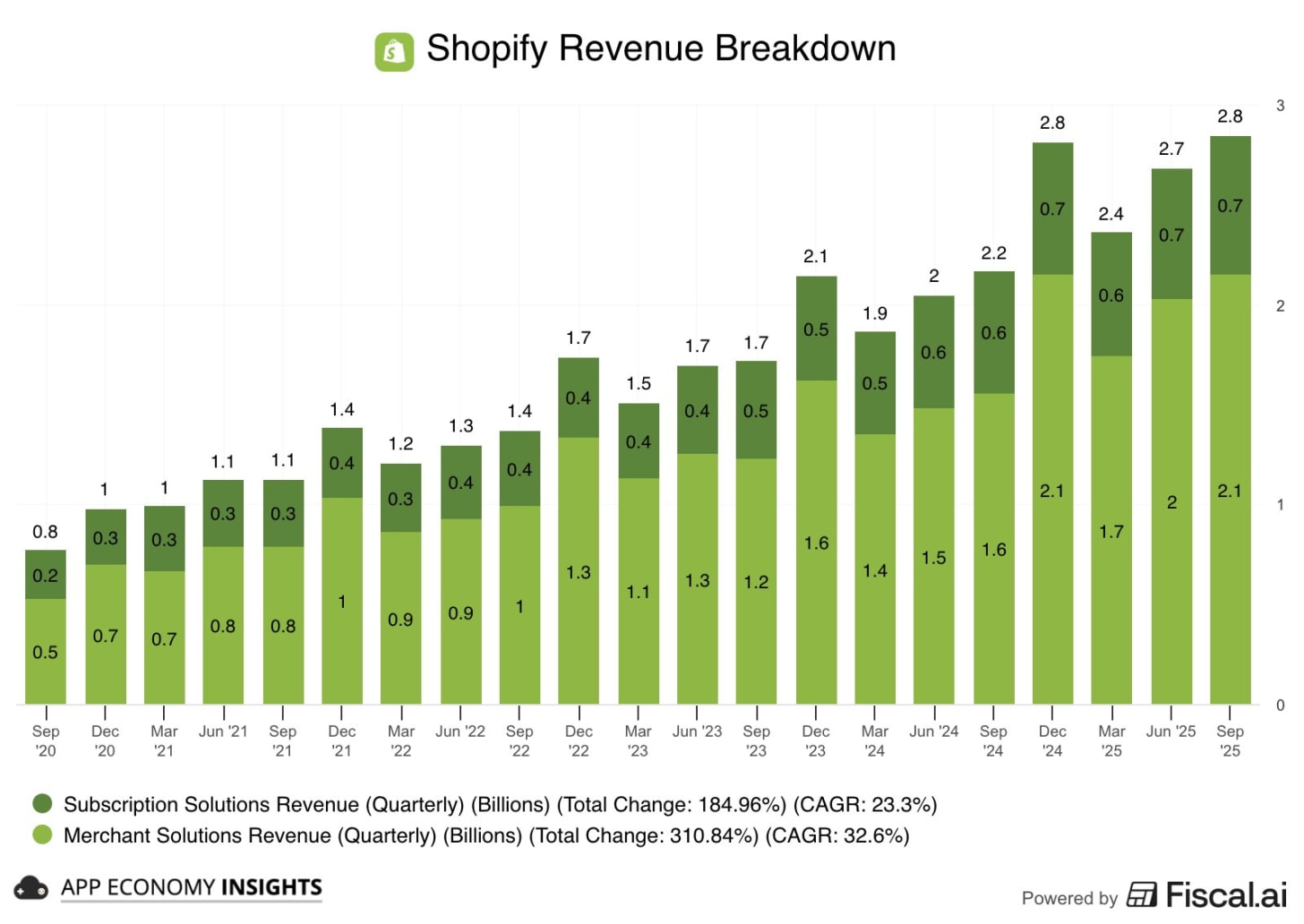
Adjusted EPS was $0.34 (in line with consensus), while GAAP net income fell to $264 million from $828 million a year ago (due to a large one-time gain on equity investments last year). Gross margin compressed to 49% (from 52% a year ago), pressured by higher R&D, marketing, and increased spending on AI infrastructure to support new tools like the “Sidekick” assistant. You could argue that gross margin compression is actually a bullish sign because it shows that merchants are actually using Shopify’s AI tools.
Shopify provided a strong Q4 revenue growth outlook in the “mid-to-high-twenties” percentage range (unchanged), ahead of consensus.
Despite the top-line beat, shares fell slightly post-earnings. Investors are likely focused on the rising AI spending. While the company’s AI tools are driving merchant adoption, investors are now weighing the high costs of the AI pivot against the platform’s resilient, share-gaining growth. AI tailwinds are clear, but now the ROI also comes into question.
Spotify’s Q3 revenue rose 7% Y/Y to €4.3 billion (€40 million beat). The company posted a strong net profit of €0.9 billion, or €3.28 per share (€1.32 beat), a significant turnaround from last quarter’s stock-based-comp-driven loss.
Monthly active users (MAUs) climbed 11% Y/Y to 713 million (3 million beat), and Premium subscribers rose 12% Y/Y to 281 million (in line with expectations).
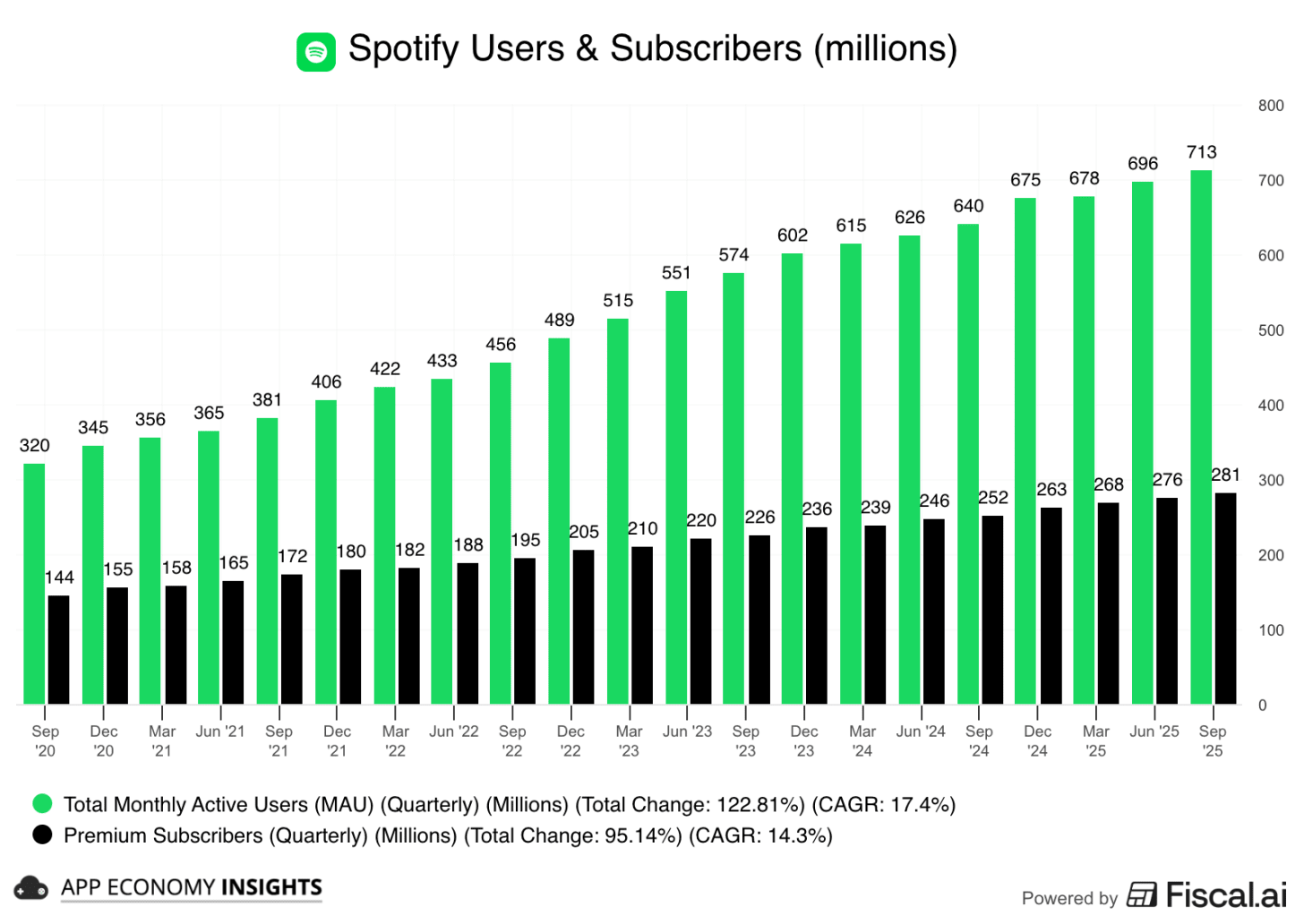
Engagement is being driven by a major push into video podcasts, which now have 500,000 shows and have been streamed by 390 million users (up 54% Y/Y). Time spent with video content on the platform has more than doubled Y/Y, and a new “ubiquity” strategy—including a new partnership with Netflix—aims to syndicate content off-platform to drive awareness and incremental usage back to Spotify.
Guidance for Q4 was mixed. While MAU and operating income forecasts were ahead of consensus, the Q4 revenue forecast of €4.5 billion was slightly below analyst expectations.
The low-light of the quarter was the continued decline in advertising revenue, which fell 6% Y/Y due to pricing pressure. Management now views 2025 as a “transition year” for ads, with no growth improvement expected until the back half of 2026. The quarter also marks a leadership transition, with CEO Daniel Ek moving to executive chairman, handing the reins to co-CEOs Gustav Söderström and Alex Norström.
That’s it for today!
A massive PRO issue drops tomorrow with over 40 companies included. Berkshire’s cash pile, Robinhood’s crypto miss, the Duolingo meltdown, and much more.
Stay healthy and invest on.
Thanks to Fiscal.ai for being our official data partner. Create your own charts and pull key metrics from 50,000+ companies directly on Fiscal.ai. Start an account for free and save 15% on paid plans with this link.
Author's Note (Bertrand here 👋🏼): The views and opinions expressed in this newsletter are solely my own and should not be considered financial advice or any other organization's views.
Disclosure: I own PLTR, AMD, SHOP, and ABNB in App Economy Portfolio. I share my ratings (BUY, SELL, or HOLD) with App Economy Portfolio members.
2025-11-04 21:03:14
Welcome to the Premium edition of How They Make Money.
Over 240,000 subscribers turn to us for business and investment insights.
In case you missed it:
Premium members love our latest Earnings Visuals report!
Digest the performance of hundreds of companies in seconds.
Amazon (AMZN) just gave Wall Street the proof it was waiting for.
Last Friday, we discussed AWS as the “most likely beneficiary” of the new deal between Microsoft and OpenAI, after Azure lost its right of first refusal on cloud infrastructure.
Well, well, well. AWS and OpenAI just inked a $38 billion seven-year deal, granting OpenAI access to hundreds of thousands of NVIDIA GPUs, with the option to scale to tens of millions of CPUs for agentic workloads.
The timing couldn’t be better. AWS growth just accelerated to 20% Y/Y, its best performance in nearly three years, showing that Amazon’s aggressive CapEx, now expected to reach $125 billion in FY25, is paying off. The stock jumped over 10% after earnings as investors rewarded tangible progress on AI monetization.
CEO Andy Jassy’s message was simple:
“We’re going to continue to be very aggressive in investing in capacity because we see the demand. As fast as we’re adding capacity right now, we’re monetizing it.”
With AWS revenue scaling past a $132 billion annual run rate, Amazon has turned a narrative of market-share anxiety into one of renewed conviction.
Today at a glance:
Amazon Q3 FY25.
The OpenAI deal implications.
Key quotes from the call.
What to watch moving forward.
Income statement:
Revenue breakdown:
💻 Online stores (37% of overall revenue): Amazon.com +10% Y/Y.
🏪 Physical store (3%): Primarily Whole Foods Market +7% Y/Y.
🧾 3rd party (24%): Commissions, fulfillment, shipping +12% Y/Y.
📢 Advertising (10%): Ad services to sellers, Twitch +24% Y/Y.
📱 Subscription (7%): Amazon Prime, Audible +11% Y/Y.
☁️ AWS (18%): Compute, storage, database, & other +20% Y/Y.
Other (1%): Various offerings, small individually +8% Y/Y.
Revenue rose +13% Y/Y to $180.2 billion ($2.4 billion beat).
Gross margin was 52% (+2pp Y/Y).
Operating margin was 10% (+0pp Y/Y).
AWS: 35% margin (-3pp Y/Y).
North America: 5% margin (-1pp Y/Y).
International: 3% margin (-1pp Y/Y).
EPS $1.65 ($0.39 beat).
Cash flow:
Operating cash flow TTM was $131 billion (+16% Y/Y).
Free cash flow TTM was $15 billion (-69% Y/Y), driven by the operating cash flow growth, offset by a 78% rise in Capex to $116 billion.
Balance sheet:
Cash, cash equivalent, and marketable securities: $94 billion.
Long-term debt: $51 billion.
Q4 FY25 Guidance:
Revenue ~$209.5 billion ($1.4 billion beat).
Operating income $21 to $26 billion (+11% Y/Y in the mid-range).
So, what to make of all this?
☁️ AWS rebounds: AWS revenue rose 20% Y/Y to $33 billion, accelerating from 17% Y/Y in Q2 and the fastest pace since 2022, showing that AI infrastructure demand is translating into growth. Custom chips and new data-center capacity helped offset power and supply constraints. Of course, AWS trails Azure’s 39% and Google Cloud’s 34% growth from lower bases, but it’s still adding the most revenue from a dollar standpoint.
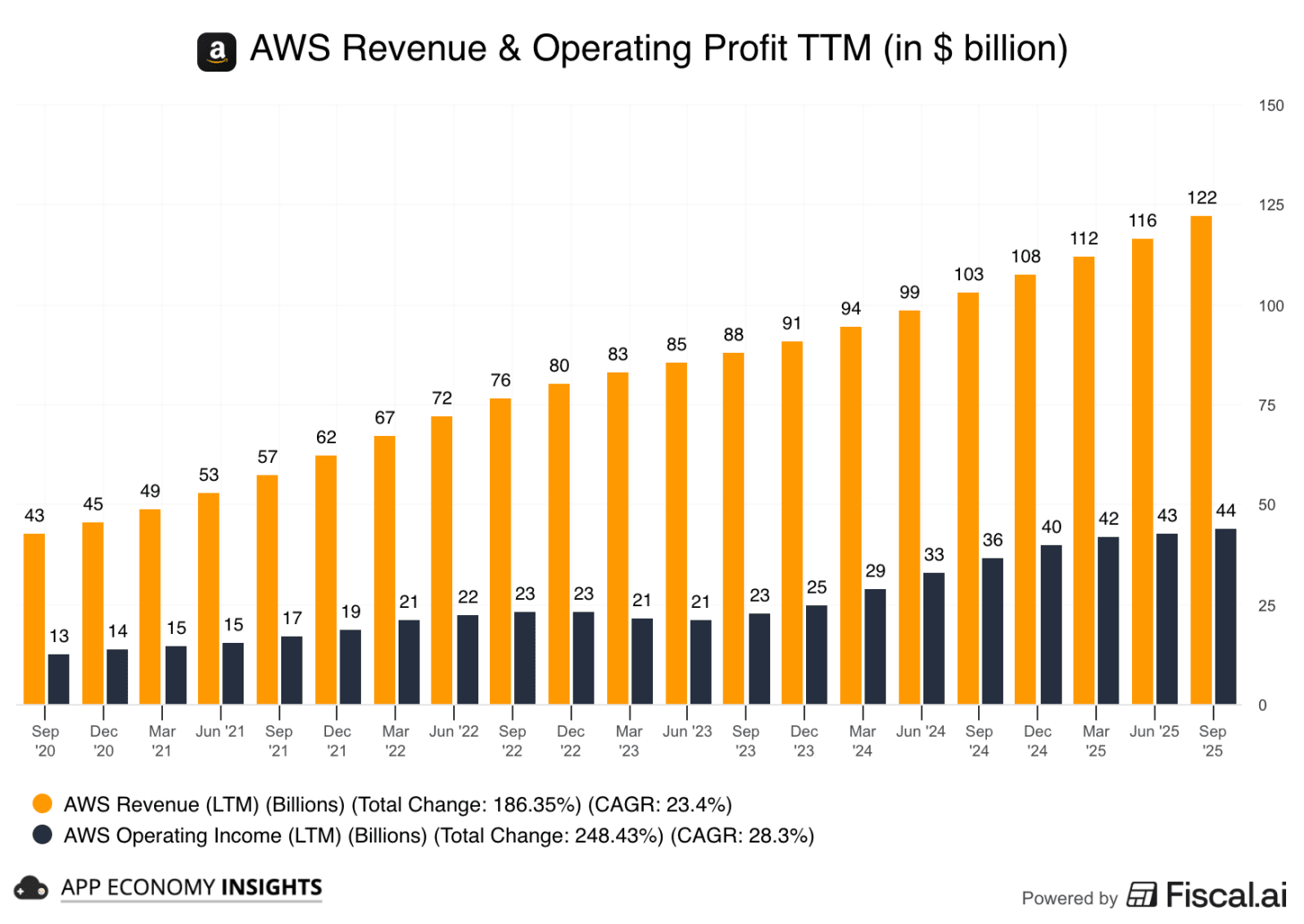
📦 Retail steady: Non-AWS revenue grew 12% Y/Y, including 11% growth in North America and 14% internationally. Prime sign-ups held steady, showing shoppers still see value despite inflation and tariffs.
🏗️ Peak CapEx: Free cash flow dropped sharply as capital expenditures ballooned past $34 billion in a single quarter. Amazon leads the world in capital spending, guiding $125 billion for FY25.
📢 Advertising keeps firing: Ad revenue surged 24% Y/Y to $17.7 billion, outpacing both Google Search and YouTube. Integrations with Roku, Disney, and Prime Video are expanding Amazon’s connected-TV footprint, while a new multi-touch attribution model is sharpening ROI and boosting advertiser confidence. This high-margin segment remains a pillar of the bull case.
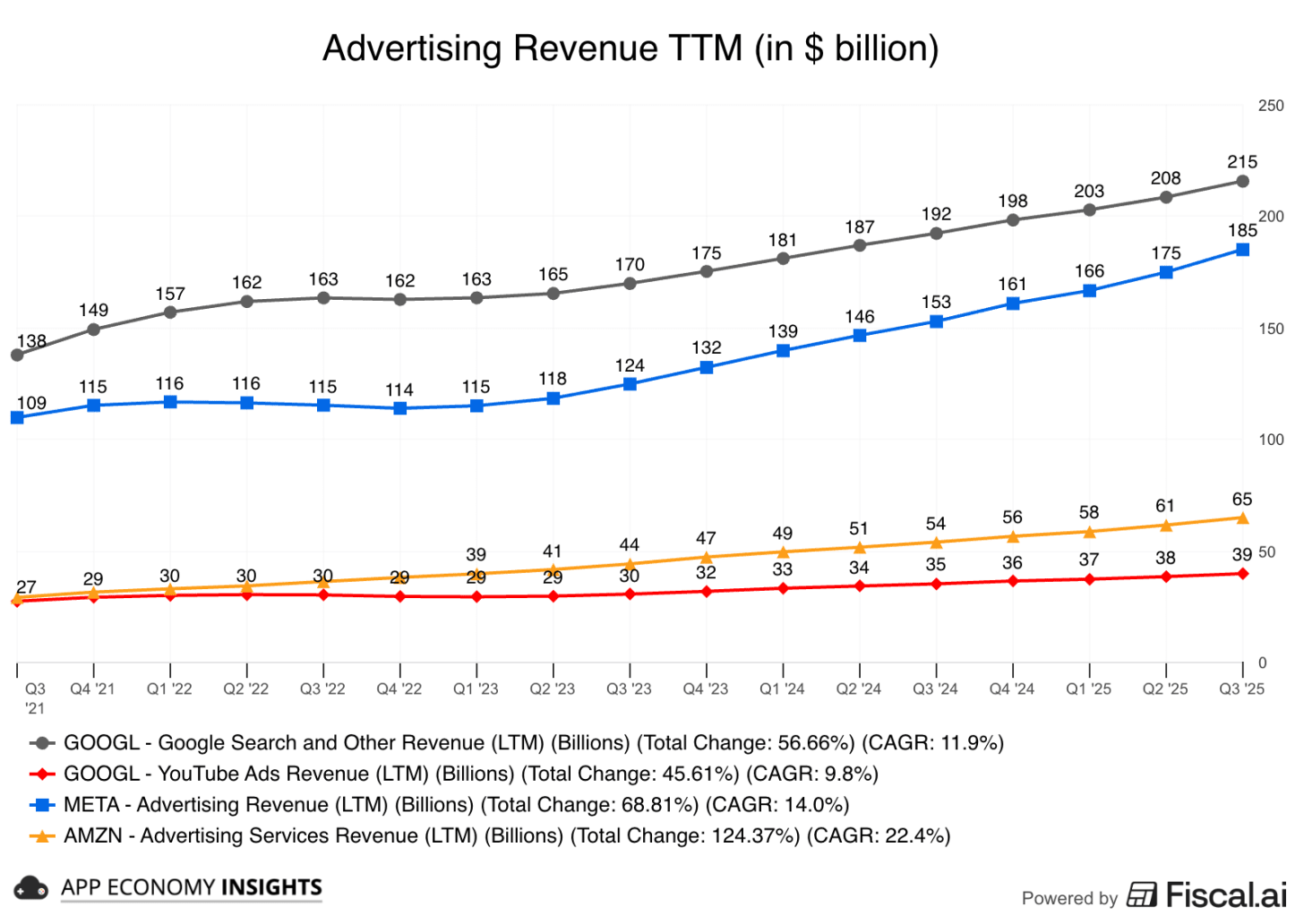
📉 Margins hold: Operating income reached $17.4 billion (flat Y/Y), but excluding one-time legal and severance costs, profits would exceed $21 billion. Company-wide margins stayed near 11%, supported by retail efficiencies and ad mix, yet free cash flow collapsed to $14.8 billion as AI-driven capex accelerated.
🔮 Guidance stays grounded: For Q4, Amazon projects $206–213 billion in revenue (+10–13% Y/Y) and $21–26 billion in operating income, implying steady but not explosive growth.
2025-11-02 23:02:23
Welcome to the Premium edition of How They Make Money.
🔥 The October report is here!
All the key earnings visuals from the past month in one place.
✔️ Cut through the noise with clear, concise financial snapshots.
✔️ See revenue trends, profit margins, and key takeaways instantly.
Download the full report below or log in to your account.
Here’s a sneak peek of the 70+ companies included. 👀
🏝️ Travel: Booking, Hilton.
💬 Social: Meta, Reddit, Roblox.
🚗 Automotive: Tesla, GM, Ford.
🍿 Entertainment: Netflix, Roku.
🌮 Franchises: Chipotle, Domino’s.
💊 Biopharma: AbbVie, Merck, J&J.
🔬 Equipment: ASML, Lam Research.
🛩️ Defense: Boeing, Lockheed Martin.
🍫 Food: Hershey, Kraft Heinz, Mondelez.
🏥 Healthcare: UnitedHealth, Intuitive, Align.
🥤 Beverage: Coca-Cola, Constellation, Pepsi.
☁️ Big Tech: Apple, Amazon, Google, Microsoft.
✈️ Airlines: American, Delta, Southwest, United.
📞 Telecom: AT&T, Comcast, Verizon, T-Mobile US.
💳 Payments: Amex, Fiserv, Visa, Mastercard, PayPal.
💰 Wealth: Morgan Stanley, Goldman Sachs, BlackRock.
⚙️ Semis: Arm, Cadence, Intel, KLA, Qualcomm, TSMC, TXN.
🏦 Banks: JPMorgan, BofA, Wells Fargo, Citigroup, Schwab, SoFi.
💻 Software: Atlassian, Confluent, Cloudflare, IBM, SAP, ServiceNow.
Plus Adidas, Coinbase, Etsy, MercadoLibre, P&G, GE Vernova, and more.